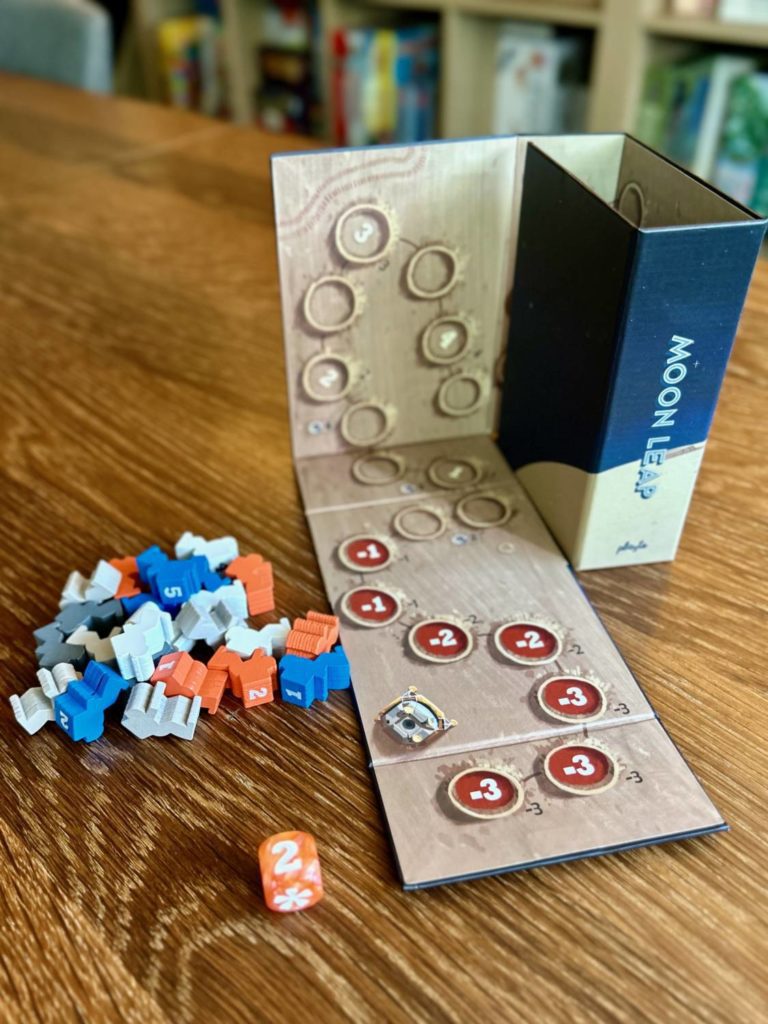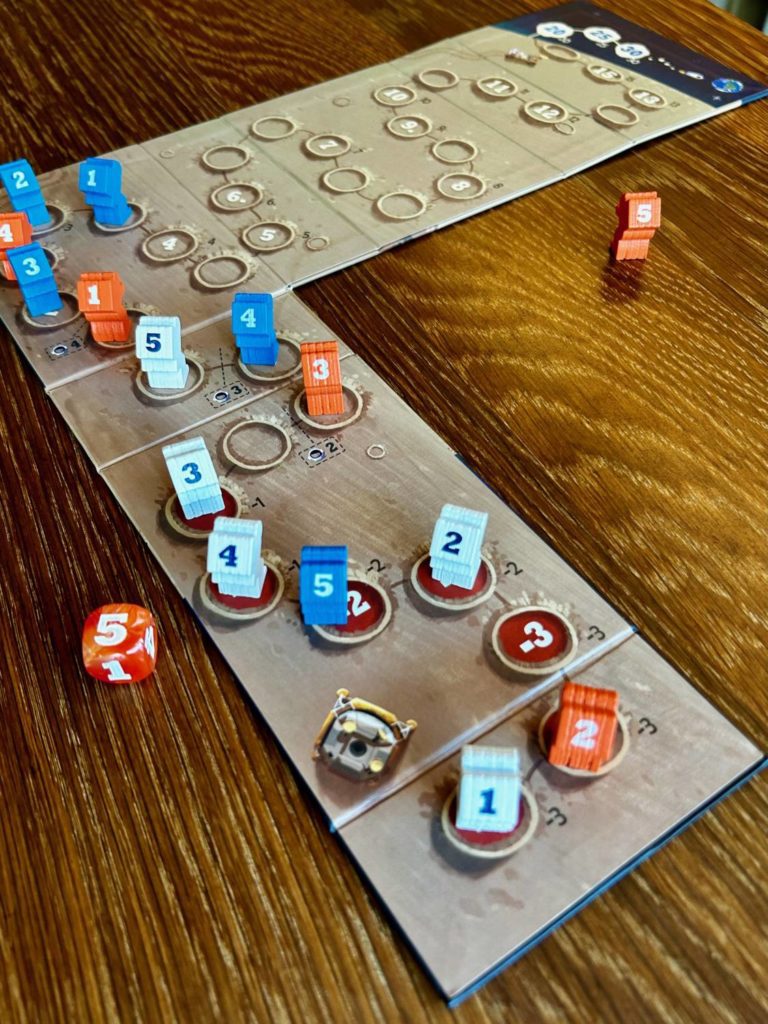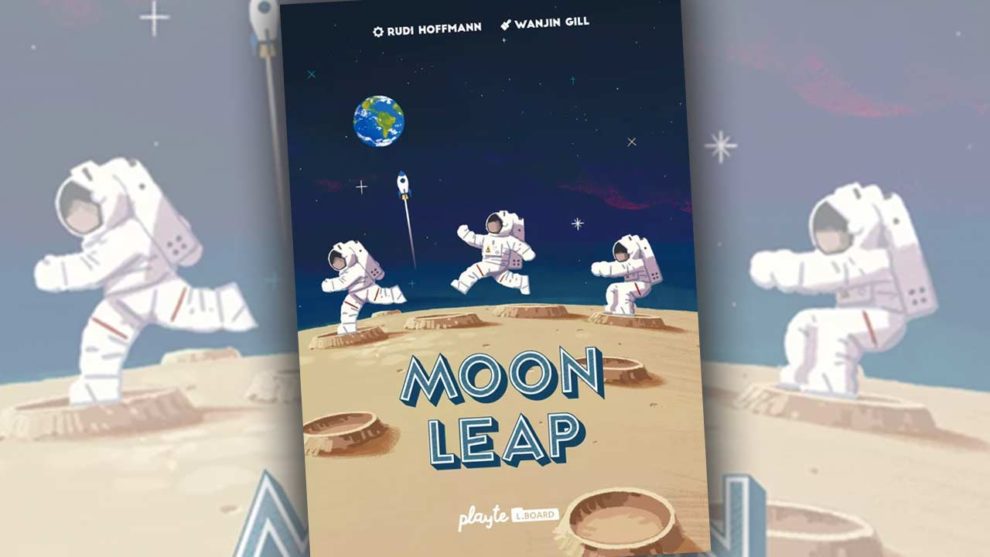Fast forward with me into a future when tourists can hop aboard a Falcon X and visit the moon. Perhaps you have come to the moon to check out the Tycho crater, which you have seen from afar, or the Sea of Tranquility that Neil Armstrong walked upon decades ago. Like him, all of us astro-tourists are jumping and leaping around each other weightlessly. Well, here we are and now we are all vying to get as close to the most coveted craters.

Space flight has been achieved! Which crater shall we visit?
The objective of the game is to score the most points by securing the most advantageous spots on the single-lane raceway made of up craters. Winning points are calculated by multiplying the number on the token with the value on the crater space.
Game play is simple; after each player has chosen their token color, the game begins with the youngest player’s starting roll. Players place and move their tokens on the board by matching them with the number on the dice roll. Each astronaut’s initial move begins on any of the available red starting craters. In consecutive moves astronaut tokens that match the dice roll move to the next available space. Only one token can be on each space. In this way, a token can move to an adjacent crater or, if it is occupied, “leap” over any other astronauts on its way to the next free space. Hence the name of the game, “Moon Leap”!
On the board are three barriers indicated for 2, 3, and 4 players. Once any of a player’s tokens have crossed the corresponding barrier, that player is permitted to divide up their rolls of 3, 4, or 5, to move up to two of their own tokens. So, if a player rolls a 5, they may move token 5, or split their roll in order to move tokens 4 and 1 or tokens 3 and 2. Both tokens must be moved. If it is not possible to move either token, the divided pair of numbers are not permitted.

Lastly, if on a turn, a token is moved so that it creates a new chain that ends with three tokens of the same color, that player gains an extra turn immediately. The game ends when the last three spaces at the end of the board are occupied.
Final scores are determined by the points received for each token. They are calculated by multiplying the number on the token with the value on the space which it has landed on. Tokens left on red craters result in negative products and any unused tokens deduct 5 points. The player with the highest total wins the game!
The perfect travel game for your first space flight
Moon Leap is such a compact game that packs in some strategic counter placement and movements, critical thinking and quantitative reasoning and for those looking to play with kids, sneaks in some multiplication practice.

One of the fun novelties of the game is that the board game is the box; it unfolds and opens up to reveal an L shape game board and the single lane race-way.
I particularly like how simple this race to the finish game is; match and move one space. But within the single action, there are a number of choices that can be made. You could add a token to the board, or move 1 corresponding token, or divide and conquer. Will moving a particular numbered token result in a larger product and a better final score? Or perhaps, attack and move forward so an opponent cannot get as far ahead?
At 2 players Moon Leap has the potential to feel like a solo endeavor to defeat your opponent in points. And because your roll is very luck-based, there may not be many opportunities for you to attack and jeopardize your opponent’s final score.

I prefer the game as a 3 player pursuit. Then, there is just enough “squeeze” on the spaces that different moves can provide gains in points. The possibilities of jumping much farther ahead open up since we are leaping over the other 2 players’ tokens. So the consequences of a second roll if three same colored tokens are in a row have even more impact. Of course, for these same reasons, it gets very crowded at 4 players, with a ratio of almost 2:1 spaces to tokens if all 20 tokens are vying for the best of the 39 spaces on the board.
Overall, this makes a great game for families to take on the road. It packs small, it has few components, the box opens up as the board so there are no loose parts and turnaround time is fast. Moon Leap makes the perfect puzzley distraction for our 3-day journey to the moon and back!












Add Comment